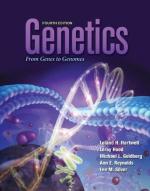|
This section contains 207 words (approx. 1 page at 300 words per page) |
The genome, (sometimes genom) is the full set of genes carried by a gamete. It comprises one representative of each of the chromosome pairs of the adult diploid parent. In other words, a genome is a single set of genetic instructions. Not all of the alleles within a genome are expressed. Some are masked by the presence of dominant forms. A genomic library, or genomic bank, is a full genome stored as recombinant DNA molecules.
The genomic formula is a mathematical expression of the number of genomes present in an individual cell or organism. One of the commonly encountered genomic formulae is the haploid which is represented by n. This is sometimes called the basic number. The diploid form, which has two sets of a genome, is 2n; the triploid is 3n, and the tetraploid is 4n. Genetic abnormalities, where one chromosome is missing from the genome, can be represented in the same manner. For example, a diploid organism with one chromosome missing is a monosomic cell and is represented by 2n-1. A diploid with two chromosomes missing is termed a nullisomic and is represented by 2n-2. Additions of chromosomes can also occur and are represented in the same form; for example, 2n+1 is trisomic.
|
This section contains 207 words (approx. 1 page at 300 words per page) |


